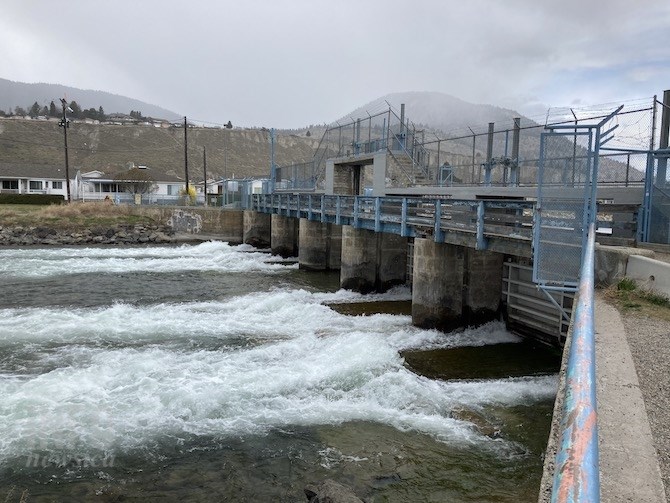
Water flows out of Okanagan Lake at the Penticton dam are about as low as they can comfortably get, not like this heavier flow last spring.
(STEVE ARSTAD / iNFOnews.ca)
July 28, 2021 - 6:30 AM
Okanagan Lake is now only about one centimetre higher than it was at this time in 2003 – which was one of the driest years on record.
As of July 26, it sat at 341.87 metres above sea level, according to Shaun Reimer, section head, public safety and protection for the Ministry of Forests and the man responsible for controlling the flow of water out of the lake in Penticton.
“We are almost exactly where we were in 2003,” he said. “When you think about what 2003 was, with the fires and the dry and the drought, conditions are very reminiscent.”
The other very dry summer since was in 2009 but the lake is currently six centimetres above that level.
The lake level keeps falling into the fall. By Sept. 30, 2003, Okanagan Lake had dropped to 341.455 metres above sea level. Given current conditions, Lake Okanagan could reach that level a month earlier this year than it did in 2003.
Right now, the lake is dropping by about one centimetre a day because of evaporation and water consumption by residents and farmers, Reimer said. That means it could take about 40 days to reach the lowest level of 2003.
“I could hold back another cubic metre per second but that would create some headaches in the Oliver area and would not really make a difference,” Reimer said.
That would only be about 1/40th of a centimetre saved per day.
Municipalities and irrigation districts throughout the Valley have imposed various levels of watering restrictions. In some cases those are strict rules on when to water outdoors while in other cases there are requests to voluntarily reduce the amount of water used.
Despite those restrictions, watering lawns doesn’t really have much of an impact on lake levels.
The Okanagan Basin Water Board tried to determine how much water was being used and for what purposes a few years ago so it surveyed all water providers.
It took a year to collect the information but many suppliers did not have clear data on where their water was being used and only six municipalities provided metered data, Anna Warwick Sears, executive director of the water board said.
Data was averaged for three different years: 1997 was a wet cool year, 2003 was hot and dry and 2010 was in between.
It found that the average Okanagan household used 1,032 litres of water each day.
That’s one of the highest rates in Canada in an area with the least amount of water per person of anywhere in Canada, according to a Statistics Canada report from 2003.
Still, households used a lot less water than farmers.
It was estimated that 136.8 million cubic metres are used for agriculture in the Valley in an average year. This does not include animal water uses, irrigation for golf courses or parks/sportsfields).
The biggest agricultural users, based on the 2016 estimates of acreage in each crop, were apples at 21.6 million cubic metres per year, grapes at 14.9 million and cherries at 11.3 million.
For indoor use, including residential, commercial, industrial and institutional, 29.3 million cubic metres were used.
Domestic outdoor landscape irrigation used 24.4 million cubic metres per year.
Just for illustration purposes, since there are many sources for water in the Valley, one centimetre of Okanagan Lake contains about 3.46 million cubic metres of water.
Forage crops are the biggest consumers of water at 7,557 cubic metres per hectare, according to a study by the Institute for Sustainable Food Systems at Kwantlen Polytechnic University.
Sweet cherries came in second at 6,502 cubic metres per hectare, apples consumed 6,160 cubic metres, vegetables 4,697 cubic metres while grapes were the most water efficient at 3,335 cubic metres.
These numbers were based on the average summer of 2010.
Low lake levels don’t necessarily mean that there’s any real risk this year of running short of water in the Okanagan, not with massive lakes like Okanagan and Kalamalka helping with the supply.
And a single dry year is not necessarily an indicator of worse to come.
The dry years of 2003 and 2009 were followed by relatively normal years so Reimer was able to raise the Okanagan Lake level to near the full pool target of 342.48 metres above sea level.
That means, letting a lawn go brown by cutting back on watering this summer really won’t make much of a difference to Okanagan Lake levels but could have a bigger impact on water supplies from other sources.
A 2015 study commissioned by the Okanagan Basin Water board estimated that strict water conservation measures would only save 1.3 cm of Okanagan Lake water from July 10 through to the end of September.
“As I read it, to me it says that in any given year, water conservation doesn’t make a huge savings for lake levels,” Warwick Sears said. “But, were we to have an extended multi-year drought, each centimeter of water becomes more and more precious and important, especially for fish.”
The big concern is whether 2022 will be like 2004 and 2010 when the rain and snow came back.
To contact a reporter for this story, email Rob Munro or call 250-808-0143 or email the editor. You can also submit photos, videos or news tips to the newsroom and be entered to win a monthly prize draw.
We welcome your comments and opinions on our stories but play nice. We won't censor or delete comments unless they contain off-topic statements or links, unnecessary vulgarity, false facts, spam or obviously fake profiles. If you have any concerns about what you see in comments, email the editor in the link above.
News from © iNFOnews, 2021